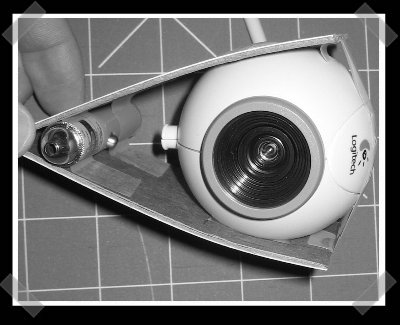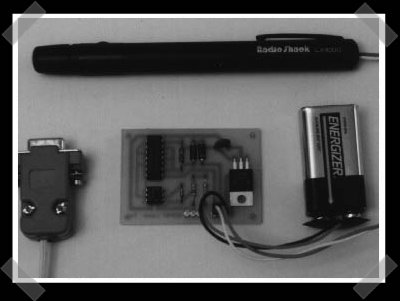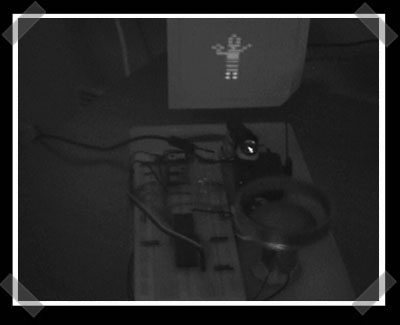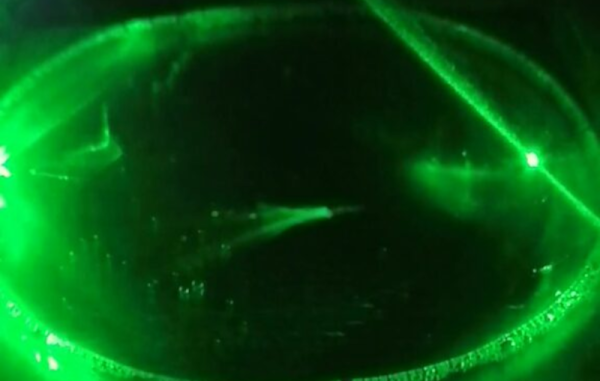
[A. Smyth] passed this along – it’s another take on the non-mechanical dance pad. The first prototype used IR detection, but apparently the hardware was flaky. The new version uses cheap laser pointer style diodes with photo detectors. Personally, I want to see one that breaks the laser into a line and collimates the resulting beam, and senses beam interference by measuring the intensity. (And it would look incredible with a fogger) The electronics are pretty simple – the photocells are interfaced with the guts of a USB game pad and breaking the beam creates a button push.
Webcam Laser Rangefinder

This has been around for a while, but I thought it deserved some attention. [Todd] used a laser pointer, a webcam, some trig and (sigh) some windows development tools to create his own laser range finder. Given the position of the beam strike and that the camera is located at a right angle to the laser, calculating the distance is pretty simple. This could be handy if you’re building a bot for defcon…
RS-232 Serial Laser Link

[ashish] sent in this one via the tips line. (Ed Note: link rot. Try this one.) It’s a project to create a laser based RS-232 link. It’s based on cheap laser pointers, a MAX232 and a photo-resistor to receive the signal.
AVR Laser Projector

I’ve seen a few simple DIY laser projectors that just oscillate the beam. This one (scroll past the pong game) has 16 lines of resolution. Sixteen mirrors are rotated by a motor, and an AVR controller pulses the laser to draw the image. Via Asish’s Programming Journal (Worth checking out, he’s been doing several webcam laser pointer projects.)
Pentium Powered Extra With Friggin’ Lasers

[Neil] sent along this one and I found this one highly amusing. The latest use for recycling those old cpus: overvolt them a bit with a USB cable and keep your coffee cup warm. Use them as dressing for heat generating resistors.
[nik] came up with a non-destructive way to mount an external wi-fi antenna to his thinkpad. I like it, but I think you need a double height PCMCIA slot to fit it – Maybe a slimmer version could be built for a powerbook/macbook.
[Hybrid] found some interesting diy LASER projects. Including a $10 air laser. Sweet.
[joek1010] noted some interesting webcam laser hacks. The laser tracing webcam has definite possibilities.
[dualbandit] found a similar twist, but this time a laser pointer is used to remote control a mediacenter.
In case you’ve been following it, my DIY HD projector build on Engadget is finished up with the final review. I’m pleased with the image quality, but I’ll probably be tweaking the lamp/reflector assembly a bit.
Oh, and if you were into exploiting vending machines and getting free coke, it looks like they’ve pushed out a firmware patch.
Remember, only 11 more days to get your entry in for the Design Challenge. Just check out the prizes if you need motivation.
Light Whiskers From Soap Bubbles Is Real Science
You might think that anything to do with a soap bubble is for kids. But it turns out that observing light scattering through a soap bubble produces unexpected results that may lead to insights into concepts as complex as space-time curvature. That’s what [stoppi] says in his latest experiment — generating “light whiskers” using a laser and a soap bubble. You can watch the video, below, but fair warning: if videos with only music annoy you, you might want to mute your speakers before you watch. On the other hand, it almost seems like a laser light show set to music.
The setup is simple and follows a 2020 Israeli-American research paper’s methodology. A relatively strong laser pointer couples to a fiber-optic cable through a focusing lens. The other end of the fiber delivers the light to the soap bubble, where it separates into strands that exhibit something called branched flow.
Our physics knowledge isn’t deep enough to explain what’s going on here. However, if you have an interest in reproducing this experiment, it doesn’t look like it takes anything exotic. The original paper has a lot to say on the topic and if that’s too heavy for you, there’s always the Sunday supplement version.
If there is ever a practical application for this, we’ll see an uptick in the design of bubble machines. Oddly, this isn’t the first time we’ve seen lasers married with bubbles.
Ptychography Shows Atoms At Amazing Resolution
Cornell University enhanced electron microscopy using a technique known as ptychography in 2018. At the time, it allowed an electron microscope to resolve things three times smaller than previously possible. But that wasn’t enough. The team has now doubled that resolution by improving on their previous work.
The team says that the images are so precise that the only blurring is due to the thermal motion of the atoms themselves. This could mean that you won’t see a further improvement in resolution in the future.
Continue reading “Ptychography Shows Atoms At Amazing Resolution”













